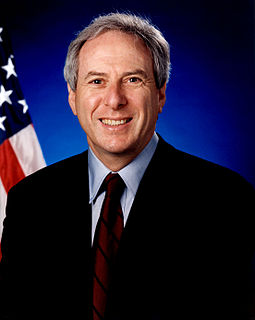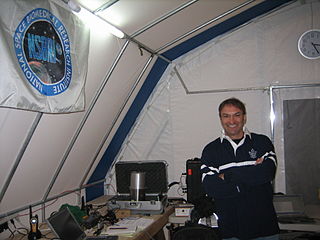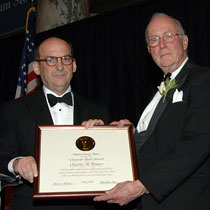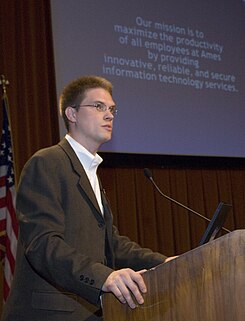
The John F. Kennedy Space Center is one of ten National Aeronautics and Space Administration field centers. Since December 1968, KSC has been NASA's primary launch center of human spaceflight. Launch operations for the Apollo, Skylab and Space Shuttle programs were carried out from Kennedy Space Center Launch Complex 39 and managed by KSC. Located on the east coast of Florida, KSC is adjacent to Cape Canaveral Air Force Station (CCAFS). The management of the two entities work very closely together, share resources, and even own facilities on each other's property.

The Ames Research Center (ARC), also known as NASA Ames, is a major NASA research center at Moffett Federal Airfield in California's Silicon Valley. It was founded in 1939 as the second National Advisory Committee for Aeronautics (NACA) laboratory. That agency was dissolved and its assets and personnel transferred to the newly created National Aeronautics and Space Administration (NASA) on October 1, 1958. NASA Ames is named in honor of Joseph Sweetman Ames, a physicist and one of the founding members of NACA. At last estimate NASA Ames has over US$3 billion in capital equipment, 2,300 research personnel and a US$860 million annual budget.

The Lyndon B. Johnson Space Center (JSC) is NASA's center for human spaceflight, where human spaceflight training, research, and flight control are conducted. It was built and leased to NASA by Joseph L. Smith & Associates, Inc. It was renamed in honor of the late US president and Texas native, Lyndon B. Johnson, by an act of the United States Senate on February 19, 1973.

Daniel Saul Goldin served as the 9th and longest-tenured Administrator of NASA from April 1, 1992, to November 17, 2001. He was appointed by President George H. W. Bush and also served under Presidents Bill Clinton and George W. Bush.
In computing and related technologies such as networking, failover is switching to a redundant or standby computer server, system, hardware component or network upon the failure or abnormal termination of the previously active application, server, system, hardware component, or network. Failover and switchover are essentially the same operation, except that failover is automatic and usually operates without warning, while switchover requires human intervention.
Human-centered computing (HCC) studies the design, development, and deployment of mixed-initiative human-computer systems. It is emerged from the convergence of multiple disciplines that are concerned both with understanding human beings and with the design of computational artifacts. Human-centered computing is closely related to human-computer interaction and information science. Human-centered computing is usually concerned with systems and practices of technology use while human-computer interaction is more focused on ergonomics and the usability of computing artifacts and information science is focused on practices surrounding the collection, manipulation, and use of information.

The Haughton–Mars Project (HMP) is an international interdisciplinary field research project being carried out near the Haughton impact crater on Canada's northern Devon Island. Human-centered computing (HCC) studies are aimed at determining how human explorers might live and work on other planetary objects, in particular on Mars. Conducted jointly by SETI and the Mars Institute, the project's goal is to utilize the Mars-like features of Devon Island and the impact crater to develop and test new technologies and field operating procedures, and to study the human dynamics which result from extended contact in close quarters. This knowledge will be used in planning missions by both humans and robots to other terrestrial bodies.

The term "computer", in use from the early 17th century, meant "one who computes": a person performing mathematical calculations, before electronic computers became commercially available. "The human computer is supposed to be following fixed rules; he has no authority to deviate from them in any detail." Teams of people were frequently used to undertake long and often tedious calculations; the work was divided so that this could be done in parallel. Frequently, the same calculations were performed independently by separate teams to check the correctness of the results.

Ayanna MacCalla Howard is an American roboticist and the School Chair for Interactive Computing, Georgia Institute of Technology. She is also the Linda J. and Mark C. Smith Endowed Chair in Bioengineering in the School of Electrical and Computer Engineering, and the director of the Human-Automation Systems (HumAnS) Lab. Currently, she is the Chair of the School of Interactive Computing in the Georgia Tech College of Computing.
NASA spinoff technologies are commercial products and services which have been developed with the help of NASA, through research and development contracts, such as Small Business Innovation Research (SBIR) or STTR awards, licensing of NASA patents, use of NASA facilities, technical assistance from NASA personnel, or data from NASA research. Information on new NASA technology that may be useful to industry is available in periodical and website form in "NASA Tech Briefs", while successful examples of commercialization are reported annually in the NASA publication "Spinoffs". The Spinoff publication has documented more than 2,000 technologies over time.

The National Aeronautics and Space Administration is an independent agency of the United States Federal Government responsible for the civilian space program, as well as aeronautics and aerospace research.

Ken Ford is founder and director of the Florida Institute for Human & Machine Cognition (IHMC).
The Florida Institute for Human & Machine Cognition (IHMC) is a not-for-profit research institute of the State University System of Florida, with locations in Pensacola and Ocala, Florida. IHMC scientists and engineers investigate a broad range of topics related to building technological systems aimed at amplifying and extending human cognitive, physical and perceptual capacities. These include artificial intelligence, robotics, human-centered computing, agile and distributed computing and many related areas.

Katherine Coleman Goble Johnson is an American mathematician whose calculations of orbital mechanics as a NASA employee were critical to the success of the first and subsequent U.S. crewed spaceflights. During her 35-year career at NASA and its predecessor, she earned a reputation for mastering complex manual calculations and helped pioneer the use of computers to perform the tasks. The space agency noted her "historical role as one of the first African-American women to work as a NASA scientist".

Chris C. Kemp is an American information technology executive. His career included leading IT at the NASA Ames Research Center in Mountain View, California, and as NASA’s first chief technology officer (CTO) for IT. Kemp is known for his role in OpenStack, an open source software project for cloud computing. He was a founder of Nebula, a company which tried to commercialize the technology, from 2011 to 2015.

The Mercury Control Center provided control and coordination of all activities associated with the NASA's Project Mercury flight operation as well as the first Project Gemini flight, Gemini 3. It was located on the Cape Canaveral Air Force Station near Launch Complex 14.
The West Computers were the African American, female mathematicians who worked as human computers at the Langley Research Center of NACA from 1943 through 1958. These women were a subset of the hundreds of female mathematicians who began careers in aeronautical research during World War II. To offset the loss of manpower as men joined the war effort, many U.S. organizations began hiring, and actively recruiting, more women and minorities during the 1940s. In 1935, the Langley Research Center had five female human computers on staff. By 1946, the Langley Research Center had recruited about 400 female human computers.

Dorothy Johnson Vaughan was an African American mathematician and human computer who worked for the National Advisory Committee for Aeronautics (NACA), and NASA, at Langley Research Center in Hampton, Virginia. In 1949, she became acting supervisor of the West Area Computers, the first African-American woman to supervise a group of staff at the center.

Mary Jackson was an African American mathematician and aerospace engineer at the National Advisory Committee for Aeronautics (NACA), which in 1958 was succeeded by the National Aeronautics and Space Administration (NASA). She worked at Langley Research Center in Hampton, Virginia, for most of her career. She started as a computer at the segregated West Area Computing division in 1951. She took advanced engineering classes and, in 1958, became NASA's first black female engineer.

Virginia Layden Tucker was an American mathematician whose work at the National Advisory Committee for Aeronautics (NACA), the precursor to NASA, allowed engineers to design and improve upon airplanes. Tucker was one of the first human computers at the NACA, served as a recruiter for the program, and later worked as an aerodynamicist and an advocate for women in mathematics.














